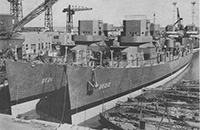Charleston Naval Shipyard
The Charleston Naval Shipyard began operations in 1901 and made shipbuilding contributions to multiple U.S. wars until its closing in 1996. Located in Charleston, South Carolina, the yard decommissioned and overhauled ships and submarines.

Written by Aaron Munz • Edited By Walter Pacheco
Asbestos.com is the nation’s most trusted mesothelioma resource
The Mesothelioma Center at Asbestos.com has provided patients and their loved ones the most updated and reliable information on mesothelioma and asbestos exposure since 2006.
Our team of Patient Advocates includes a medical doctor, a registered nurse, health services administrators, veterans, VA-accredited Claims Agents, an oncology patient navigator and hospice care expert. Their combined expertise means we help any mesothelioma patient or loved one through every step of their cancer journey.
More than 30 contributors, including mesothelioma doctors, survivors, health care professionals and other experts, have peer-reviewed our website and written unique research-driven articles to ensure you get the highest-quality medical and health information.
About The Mesothelioma Center at Asbestos.com
- Assisting mesothelioma patients and their loved ones since 2006.
- Helps more than 50% of mesothelioma patients diagnosed annually in the U.S.
- A+ rating from the Better Business Bureau.
- 5-star reviewed mesothelioma and support organization.
Testimonials
My family has only the highest compliment for the assistance and support that we received from The Mesothelioma Center. This is a staff of compassionate and knowledgeable individuals who respect what your family is experiencing and who go the extra mile to make an unfortunate diagnosis less stressful. Information and assistance were provided by The Mesothelioma Center at no cost to our family.LashawnMesothelioma patient’s daughter
How to Cite Asbestos.com’s Article
APA
Munz, A. (2023, August 23). Charleston Naval Shipyard. Asbestos.com. Retrieved April 19, 2024, from https://www.asbestos.com/shipyards/charleston-naval-shipyard/
MLA
Munz, Aaron. "Charleston Naval Shipyard." Asbestos.com, 23 Aug 2023, https://www.asbestos.com/shipyards/charleston-naval-shipyard/.
Chicago
Munz, Aaron. "Charleston Naval Shipyard." Asbestos.com. Last modified August 23, 2023. https://www.asbestos.com/shipyards/charleston-naval-shipyard/.
The shipyard flourished during World War I. It faced uncertainty during the great depression until the start of World War II. In 1932, the facility employed less than 250 workers. But by 1943, with World War II in full effect, the yard was employing almost 26,000 workers.
Charleston Naval Shipyard was a significant source of asbestos exposure. The yard used asbestos for its fireproofing and insulating properties. Unfortunately, exposure to asbestos can cause a number of respiratory conditions. These include lung cancer, asbestosis and mesothelioma.
By the late 1990s, residents living near the old shipyard expressed concern. A growing number of pleural cancers were diagnosed in the area. Researchers found that pleural cancers in the region were four times more than the expected incidence rate. Two-thirds were diagnosed in former Charleston Naval Shipyard workers.
In 2021, the International Journal of Environmental Health Research a review. It said sailors from Nordic countries have more than double the risk of developing mesothelioma.
In 2017, a study looked at the risk of mesothelioma among shipyard workers. Those exposed to a moderate amount of asbestos were about four times more likely to die of mesothelioma.
Charleston Naval Shipyard and Asbestos Exposure
The U.S. Navy understood asbestos was hazardous, yet used asbestos-containing materials. They used it throughout much of the 20th century. It wasn’t until 1978 that the Navy made a plan to remove asbestos from ships in 1978. The report outlined steps for safely performing asbestos abatement on ships.
After the shipyard closed in 1996, people who lived nearby were worried about what would happen to the area. They were concerned that asbestos might be released into the air. About 340 acres of the site are currently being revitalized into a sustainable urban hub for the city of North Charleston.
To make sure the air around the area was safe, the South Carolina Department of Health and Environmental Control did a study. They checked the air while the construction was happening. This aimed to keep the people in nine nearby neighborhoods safe.
Neighborhoods included in the study:
- Rosemont
- Silver Hill
- Four Mile
- Five Mile
- Union Heights
- Howard Heights
- Chicora-Cherokee
- Accabee
- Winslow
Asbestos exposure can occur in neighborhoods around shipyards, asbestos processing and manufacturing plants as well as asbestos mining operations. Limiting this exposure is crucial to protect nearby residents.

Charleston Naval Shipyard Contributions
From 1901 to 1996, the Charleston Naval Shipyard gave jobs to thousands of shipyard workers and did different projects for the Navy. The yard built a total of 229 ships during World War II. After the war and when shipbuilding declined, the Navy assigned the yard to become a submarine overhaul facility.
During the Korean War, the Charleston Naval Shipyard was asked to take a break from submarines and increase its production once again. The yard activated 44 vessels and converted 27 for active duty during the war. Yet production declined once more following the Vietnam War and the yard was eventually closed on April 1, 1996.







